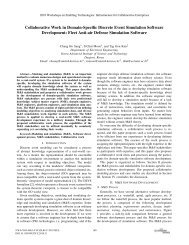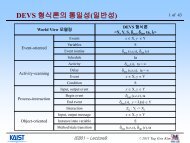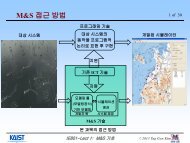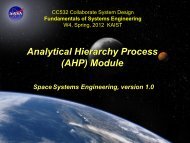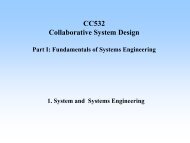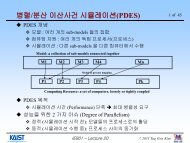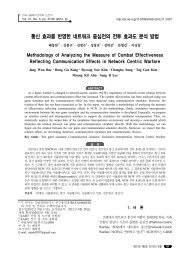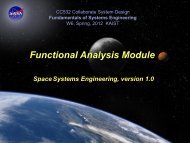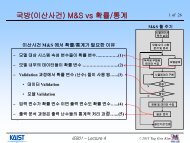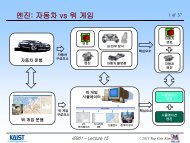System Architecture Module - Systems Modeling Simulation Lab ...
System Architecture Module - Systems Modeling Simulation Lab ...
System Architecture Module - Systems Modeling Simulation Lab ...
You also want an ePaper? Increase the reach of your titles
YUMPU automatically turns print PDFs into web optimized ePapers that Google loves.
CC532 Collaborate <strong>System</strong> Design<br />
Fundamentals of <strong>System</strong>s Engineering<br />
Spring, 2012 KAIST<br />
<strong>System</strong> <strong>Architecture</strong> <strong>Module</strong><br />
Space <strong>System</strong>s Engineering, version 1.0<br />
Space <strong>System</strong>s Engineering: <strong>System</strong> <strong>Architecture</strong> <strong>Module</strong>
<strong>Module</strong> Purpose: <strong>System</strong> <strong>Architecture</strong><br />
<br />
Place system architecture development in context with needs<br />
analysis, conops, functional analysis and system design.<br />
<br />
Understand what system architectures are and some<br />
techniques for how they are developed.<br />
<br />
Acknowledge that architecture development is usually an<br />
inductive process that benefits from heuristics and the<br />
experience of the systems engineer creating the architecture<br />
(who is also known as the system architect).<br />
Space <strong>System</strong>s Engineering: <strong>System</strong> <strong>Architecture</strong> <strong>Module</strong> 2
The Starting Point<br />
“It must be remembered that there is nothing more<br />
difficult to plan, more doubtful of success, nor more<br />
dangerous to manage than the creation of a new system.”<br />
- Niccolo Machiavelli, The Prince (군주론)<br />
Space <strong>System</strong>s Engineering: <strong>System</strong> <strong>Architecture</strong> <strong>Module</strong> 3
What Is an <strong>Architecture</strong><br />
It is the fundamental and unifying system structure<br />
defined in terms of system elements, interfaces,<br />
processes, constraints, and behaviors.<br />
• Source: International Council on <strong>System</strong>s Engineering (INCOSE) <strong>System</strong> <strong>Architecture</strong><br />
Working Group<br />
It is the structure of components, their relationships,<br />
and the principles and guidelines governing their<br />
design and evolution over time.<br />
• Source: Department of Defense (DOD) <strong>Architecture</strong> Framework v1.0<br />
A system architecture is the link between needs<br />
analysis, project scoping and functional analysis and<br />
the first descriptions of the system structure.<br />
Space <strong>System</strong>s Engineering: <strong>System</strong> <strong>Architecture</strong> <strong>Module</strong> 4
Developing A <strong>System</strong> <strong>Architecture</strong><br />
Creating an architecture is the beginning of the system design process<br />
and establishes the link between requirements and design. The typical<br />
architecture development sequence is:<br />
1. Establish initial system requirements by needs analysis, project<br />
scoping, and the development of the concept of operations (conops).<br />
2. Define the external boundaries, constraints, scope, context,<br />
environment and assumptions.<br />
3. Develop candidate system architectures as part of an iterative process<br />
using these initial requirements.<br />
4. For each architecture, compare the benefits, costs, risks and the<br />
requirements that drive their salient features and consider modifying<br />
(with stakeholder involvement) their conops, system performance and<br />
even their system functions to improve the solution-problem<br />
proposition. (AoA: Analysis of Alternatives)<br />
Space <strong>System</strong>s Engineering: <strong>System</strong> <strong>Architecture</strong> <strong>Module</strong> 5
Developing Candidate <strong>System</strong><br />
<strong>Architecture</strong>s is Recursive and Iterative<br />
Needs Analysis<br />
What needs are we trying to fill<br />
How are current solutions insufficient<br />
Are the needs completely described<br />
ConOps<br />
Functional<br />
Requirements<br />
<strong>System</strong><br />
<strong>Architecture</strong>s<br />
Who are the intended users<br />
How will the system be used<br />
How is this use different from heritage<br />
systems<br />
What capabilities are required<br />
At what level of performance<br />
Are segment interfaces well defined<br />
What is the overall approach<br />
What elements make up this approach<br />
Are these elements complete, logical,<br />
and consistent<br />
Work With Customer<br />
to Potentially Modify<br />
Problem Statement<br />
Based on Solution<br />
Options<br />
Work With Customer<br />
to Potentially Modify<br />
Problem Statement<br />
Based on Solution<br />
Options<br />
Space <strong>System</strong>s Engineering: <strong>System</strong> <strong>Architecture</strong> <strong>Module</strong> 6
So How Do We Create <strong>Architecture</strong>s<br />
There are two primary techniques to create architectures, both benefit<br />
from understanding the performance and limitations of heritage<br />
systems.<br />
Synthesis<br />
• Modifying or combining existing systems to satisfy stated needs<br />
• Requires logic and good knowledge of existing systems<br />
• What functions do I need to get the job done<br />
• Can I combine existing systems without too much baggage<br />
Discovery<br />
• Leverage knowledge of existing architectures to „discover‟ a new one<br />
• Requires knowledge of existing systems and abstraction skills<br />
• Is there an analogous system in another domain<br />
• What are the good or bad properties of a given architecture<br />
Space <strong>System</strong>s Engineering: <strong>System</strong> <strong>Architecture</strong> <strong>Module</strong> 7
Four Deductive or Inductive Methods<br />
Support Synthesis and Discovery<br />
Science-based, deductive methods: (연역적: 일반적<br />
명제들구체적 결론)<br />
• Normative (규범적)<br />
• Hard rules are provided (from somewhere), success is defined by<br />
following the rules<br />
• “If it doesn‟t look like what we are doing now it must be wrong.”<br />
• Rational (합리적)<br />
• Solutions derived from objectives<br />
• General systems problem solvers, optimization and formal techniques<br />
• Rule based<br />
Art-based, inductive methods: (귀납법: 구체적 사실<br />
일반화된 결론)<br />
• Participative (참여적)<br />
• Solution from group process, design by group consensus. Stakeholders<br />
involved<br />
• Heuristic (체험적)<br />
• Lessons learned based<br />
• Develop solutions through soft rules that are driven by experience<br />
Space <strong>System</strong>s Engineering: <strong>System</strong> <strong>Architecture</strong> <strong>Module</strong> 8
Architecting Focuses on Refining the Problem to Be<br />
Solved While Developing Conceptual Solutions<br />
The development of a system architecture, also called „architecting‟, is<br />
a systems engineering responsibility. It is the art and science of<br />
purpose determination and concept formulation.<br />
The essence of architecting is structuring, simplification, compromise,<br />
and balance.<br />
This balance is achieved by appropriate compromise between:<br />
• <strong>System</strong> requirements<br />
• Function<br />
• Form<br />
• Simplicity<br />
• Robustness<br />
• Affordability<br />
• Complexity<br />
• Environmental imperatives, and<br />
• Human factors<br />
Candidate architectures are compared using these factors and a<br />
baseline, or agreed to system architecture is chosen.<br />
• A choice is made despite the typically large uncertainties and occasionally<br />
ambiguous customer priorities.<br />
Space <strong>System</strong>s Engineering: <strong>System</strong> <strong>Architecture</strong> <strong>Module</strong> 9
Pause and Learn Opportunity<br />
Have the students read the article on the Apollo<br />
architecture decision to use Lunar Orbit Rendezvous<br />
(Apollo_LOR_1971.pdf).<br />
At the board, outline the alternative architectures that<br />
were under consideration for the Apollo missions.<br />
Earth-orbit rendezvous<br />
Direct ascent<br />
Lunar-orbit rendezvous<br />
Discuss the pros and cons of each and why LOR<br />
became the preferred architecture.<br />
Space <strong>System</strong>s Engineering: <strong>System</strong> <strong>Architecture</strong> <strong>Module</strong>
Pause and Learn Opportunity, part 2<br />
Extend the discussion to include NASA‟s current plans<br />
on returning crews to the Moon using a combination of<br />
Earth-orbit rendezvous and Lunar-orbit rendezvous.<br />
What are the resulting architecture elements<br />
What are the pros of this approach<br />
Use the speech by M. Griffin to get a better<br />
understanding of the NASA architecture (MG-STAspeech/ESAS-arch_1/22/08.doc).<br />
View the architecture representation with the graphic<br />
on the next slide.<br />
Space <strong>System</strong>s Engineering: <strong>System</strong> <strong>Architecture</strong> <strong>Module</strong>
Ares V<br />
Ares I<br />
NASA Constellation Program<br />
Lunar Sortie Mission <strong>Architecture</strong> (2006)<br />
EDS, LSAM<br />
CEV<br />
MOON<br />
Vehicles are not to scale.<br />
100 km<br />
LSAM Performs LOI<br />
Low Lunar<br />
Orbit<br />
Ascent Stage<br />
Expended<br />
Low<br />
Earth<br />
Orbit<br />
Earth Departure<br />
Stage Expended<br />
Service<br />
<strong>Module</strong><br />
Expended<br />
EARTH<br />
Direct Entry or<br />
Skip Landing<br />
Space <strong>System</strong>s Engineering: <strong>System</strong> <strong>Architecture</strong> <strong>Module</strong> 12
<strong>Architecture</strong> vs. Design<br />
A system architecture creates the conceptual structure within<br />
which subsequent system design occurs.<br />
Developing a system architecture and developing a system<br />
design are systems engineering functions that support system<br />
synthesis, but they have different uses.<br />
<strong>System</strong> architecture is used:<br />
• To establish the framework (i.e., constrains the trade space) for subsequent<br />
system design<br />
• To support make-buy decisions<br />
• To discriminate between alternative solutions<br />
• To „discover‟ the true requirements or the „true‟ priorities<br />
<strong>System</strong> design is used:<br />
• To develop system components that meet functional and performance<br />
requirements and constraints<br />
• To build the system<br />
• To understand the system-wide ripple effects of configuration changes<br />
Space <strong>System</strong>s Engineering: <strong>System</strong> <strong>Architecture</strong> <strong>Module</strong> 13
Describing a Space <strong>System</strong> <strong>Architecture</strong><br />
No one figure or diagram can capture a system‟s architecture -<br />
it requires different „views‟ or perspectives.<br />
<strong>Architecture</strong> descriptions are what we produce:<br />
• Spacecraft renderings and subsystem block diagrams<br />
• Space system communication flow diagrams<br />
• Functional flow diagrams - sometimes captured in functional flow<br />
block diagrams (FFBDs; as discussed in Functional Analysis<br />
<strong>Module</strong>)<br />
• Subsystem interface diagrams - frequently captured in N-squared<br />
diagrams (as discussed in Interfaces <strong>Module</strong>)<br />
By analogy with a building architecture, these are the<br />
blueprints, elevations, floor plans, budgets, wiring plans, etc.<br />
Space <strong>System</strong>s Engineering: <strong>System</strong> <strong>Architecture</strong> <strong>Module</strong> 14
NASA Integrated Services Network (NISN)<br />
L2 Point<br />
L2 Lissajous Orbit<br />
L2 Transfer Trajectory<br />
The James Webb Space Telescope<br />
Communications <strong>Architecture</strong><br />
Observatory<br />
Segment<br />
<br />
<br />
<br />
<br />
The launch vehicle injects observatory into an L2<br />
transfer trajectory<br />
The observatory operates at L2 point for 5 years with a<br />
goal of 10 years, providing imagery and spectroscopy<br />
in the Near and Mid Infrared wavebands.<br />
The Ground Segment receives downloads of science<br />
data and sends command uploads during daily 4 hour<br />
contacts<br />
Ground Segment uploads plans to the Observatory<br />
~once a week and the observatory autonomously<br />
executes these plans<br />
STScI Science & Operations<br />
Center (S&OC)<br />
NASA Provided<br />
Communication<br />
Asset for Early<br />
Orbit Phase<br />
Launch<br />
Segment<br />
Madrid<br />
Goldstone Canberra<br />
JPL<br />
Deep Space<br />
Network<br />
(DSN)<br />
Ground Segment<br />
GSFC<br />
Flight<br />
Dynamics<br />
Facility (FDF)<br />
Observatory<br />
Simulators<br />
(OTB/STS)<br />
Flight<br />
Operations<br />
Subsystem<br />
(FOS)<br />
Data<br />
Management<br />
Subsystem<br />
(DMS)<br />
Operations<br />
Script<br />
Subsystem<br />
(OSS)<br />
Project<br />
Reference DB<br />
Subsystem<br />
(PRDS)<br />
Wavefront<br />
Sensing &<br />
Control Exec<br />
(WFSC Exec)<br />
Proposal<br />
Planning<br />
Subsystem<br />
(PPS)<br />
Space <strong>System</strong>s Engineering: <strong>System</strong> <strong>Architecture</strong> <strong>Module</strong> 15
Space <strong>System</strong>s Engineering: <strong>System</strong> <strong>Architecture</strong> <strong>Module</strong> 16
Magellan Spacecraft Subsystem Block Diagram<br />
Shows Some of its Communications Interfaces<br />
For Venus, 1989<br />
Space <strong>System</strong>s Engineering: <strong>System</strong> <strong>Architecture</strong> <strong>Module</strong> 17
<strong>Module</strong> Summary: <strong>System</strong> <strong>Architecture</strong><br />
Creating a system architecture is a systems engineering function that<br />
is the first step in translating a defined problem into a solution.<br />
Creating an architecture is a recursive, iterative process that begins<br />
with the problem statement, creates some candidate solutions,<br />
assesses their merits and chooses one.<br />
<strong>Architecture</strong> creation is not a deterministic process, but understanding<br />
the strengths, weaknesses and adaptability of heritage or analogous<br />
systems is a valuable first step.<br />
In working with the stakeholders, the function or performance<br />
requirements of the system may be modified to create a better match<br />
between the problem statement and the candidate solution.<br />
Like many systems engineering functions, architecting is one of<br />
balancing competing factors and choosing a preferred solution with<br />
uncertain and sometimes ambiguous information.<br />
No one view captures an architecture. Many views are used to capture<br />
the system structure defined in terms of system elements, interfaces,<br />
processes, constraints, and behaviors.<br />
Space <strong>System</strong>s Engineering: <strong>System</strong> <strong>Architecture</strong> <strong>Module</strong> 18
Space <strong>System</strong>s Engineering: <strong>System</strong> <strong>Architecture</strong> <strong>Module</strong><br />
Backup Slides<br />
for <strong>System</strong> <strong>Architecture</strong> <strong>Module</strong>
Building <strong>Architecture</strong>s<br />
Illuminate by Analogy<br />
The architect works for the client and<br />
with the builder.<br />
You expect the architect to help develop<br />
requirements.<br />
• Both architects and systems engineers<br />
build self-consistent, balanced problemsolutions<br />
pairs.<br />
Architects produce abstracted designs.<br />
• Floor plans, elevations, cost estimates,<br />
etc. are not complete building plans, but<br />
they are necessary for complete building<br />
plans.<br />
<strong>Architecture</strong> descriptions and the<br />
architecture itself are different.<br />
• The floor plan is not the architecture, nor is the<br />
elevation, nor is the cost estimate.<br />
A good architecture representation is<br />
not just the physical structure, there are<br />
many views.<br />
Mark Maier and Eberthardt Rechtin - The Art<br />
of <strong>System</strong>s Architecting; CRC Press, 2000<br />
Space <strong>System</strong>s Engineering: <strong>System</strong> <strong>Architecture</strong> <strong>Module</strong> 20
The Three Views of the DOD <strong>Architecture</strong> Framework<br />
Common <strong>Architecture</strong> Environment<br />
Operational<br />
Operational tasks, elements and<br />
information flows required to<br />
accomplish military operation<br />
Op Concept<br />
Command<br />
Relationships<br />
OpNode<br />
Activity<br />
Connectivity<br />
Op Event/<br />
Model<br />
Trace<br />
Op Info<br />
Exchange<br />
Logical<br />
Data<br />
Op Op State<br />
Op Rules Model<br />
Transition<br />
<strong>System</strong><br />
<strong>System</strong>s and interconnections<br />
providing for or supporting<br />
military operation<br />
Physical<br />
<strong>System</strong> Tech<br />
Data Model<br />
Sys Forecast<br />
Interface<br />
<strong>System</strong><br />
<strong>System</strong><br />
Desc<br />
Performance<br />
<strong>System</strong> Rules<br />
Event/<br />
Comms<br />
Trace Desc<br />
<strong>System</strong> Info<br />
Desc<br />
Exchange<br />
<strong>System</strong>s<br />
Op Activity<br />
Functionality<br />
-to-<br />
<strong>System</strong>s2 2<br />
State<br />
<strong>System</strong> Matrix<br />
Func<br />
Transitions<br />
Technical<br />
Minimal set of rules governing<br />
the arrangement, interaction<br />
and interdependencies of<br />
system parts or elements<br />
Technology<br />
<strong>Architecture</strong><br />
Technology<br />
<strong>Architecture</strong><br />
Profile<br />
Profile<br />
Standards<br />
Technology<br />
Standards<br />
Forecast<br />
Technology<br />
Forecast<br />
Space <strong>System</strong>s Engineering: <strong>System</strong> <strong>Architecture</strong> <strong>Module</strong> 21
Elements of Pre Phase A<br />
Mission <strong>Architecture</strong><br />
• Mission Overview<br />
• Science Objectives<br />
• Quad Chart<br />
• Technology Needs and Assessment<br />
• Project’s Relation to Program<br />
• Mission Requirements<br />
• Project <strong>System</strong> Description<br />
- Key Drivers (hardware & software)<br />
- Redundancy<br />
- Fault Protection Concept (hardware & software)<br />
- <strong>Architecture</strong><br />
- Software <strong>Architecture</strong><br />
- <strong>System</strong> Trades<br />
- Flight <strong>System</strong> Mass Breakdown (w. margins)<br />
- Flight <strong>System</strong> Power Breakdown (w. margins)<br />
- End-to-End Information <strong>System</strong> Concept<br />
- Data Return Budget and Margins<br />
- Design Principles Exceptions<br />
- <strong>System</strong> Margin Summary: mass, power, cost, performance<br />
• Mission Description<br />
- Environmental Conditions<br />
- Key Drivers<br />
- Mission Trades<br />
- Orbit and Trajectory (w. margins)<br />
- Navigation Concept<br />
- Launch Vehicle: Packaging, Mass and Margin; Stowed Configuration; Launch<br />
Strategy<br />
• Payload Conceptual Design<br />
- Payload Configuration Diagram (s), Stowed and Deployed<br />
- Block Diagram<br />
- Heritage (hardware & software)<br />
- Mass (w. contingency)<br />
- Power (w. contingency)<br />
- Size (w. contingency)<br />
- Data Rates<br />
- Pointing Characteristics<br />
- Thermal Characteristics<br />
- Software Description<br />
- Technology Maturity Matrix<br />
• Flight <strong>System</strong> Descriptions (bus,lander, etc.)<br />
- Configuration Diagram (s), Stowed and Deployed<br />
- Subsystem Concepts & Block Diagrams<br />
- Heritage (hardware & software)<br />
- Mass (w. contingency)<br />
- Power (w. contingency)<br />
- Size<br />
- Downlink/Uplink Rates<br />
- Pointing Capability<br />
- Thermal Capability<br />
- Software Description<br />
- Technology Maturity Matrix<br />
• Mission Operations Concept<br />
- Concept Description<br />
- Key Drivers<br />
- Operations Scenario<br />
- Flight/Ground Interface<br />
- Overview of Mission-Critical Scenarios<br />
- Ground Data <strong>System</strong><br />
- DSN Support or Other Ground Stations<br />
- Software Description<br />
- Data Archive Concept<br />
- Technology Maturity Matrix<br />
• Project implementation Approach<br />
- WBS, WBS Dictionary<br />
- Implementation Approach (who does what)<br />
- Project Organization Chart<br />
- JPL Workforce Estimates<br />
- Project Schedule<br />
- Planetary Protection Strategy<br />
- Launch Approval Strategy<br />
- Outreach & Commercialization Plan<br />
• Constraints<br />
• Requirements Flowdown/Mission Traceability Matrix<br />
- Science -> Mission -> <strong>System</strong><br />
- Requirements and Constraints Compliance Matrix (L1 requirements, HQ,<br />
programmatic, institutional)<br />
• Verification/Validation Description<br />
- ATLO<br />
- Environmental Qualification<br />
- Mission V&V<br />
- Software<br />
- Fault Protection<br />
• Technology Development Approach<br />
– Technology List<br />
– Technology Readiness Levels (TRL‟s)<br />
– Key Technology Descriptions<br />
– Technology Development Milestones<br />
• Risk Management Approach<br />
- Risk Assessment and Mitigation Strategy and Risk Rating<br />
- Risk List<br />
• Costs and Risk Summary<br />
- Cost-Risk Estimates by Phase and WBS (w/ reserves)<br />
- Schedule Risk (w/ reserves and critical path identified)<br />
- Design-to-Cost-Risk Trades<br />
• JPL Institutional Impact Assessment<br />
- Workforce Needs<br />
- Facilities<br />
- DSN Usage<br />
- Budget<br />
– % Probability of Proceeding to Implementation<br />
Space <strong>System</strong>s Engineering: <strong>System</strong> <strong>Architecture</strong> <strong>Module</strong> 22
Product <strong>Architecture</strong><br />
Product architecture is the arrangement of the physical elements of a<br />
product to carry out its required functions<br />
It is in the Embodiment design phase that the layout and architecture of<br />
the product must be established by defining what the basic building<br />
blocks of the product should be in terms of what they do and what their<br />
interfaces will be between each other. Some organizations refer to this<br />
as system-level design<br />
There are two entirely opposite styles of product architecture, modular<br />
and integral:<br />
• Modular: components (chunks) implement only one or a few<br />
functions and the interactions are well defined<br />
• Integral: implementation of functions uses only one or a few<br />
components (chunks) leading to poorly defined interactions<br />
between components (chunks)<br />
In integral product architectures components perform multiple functions<br />
Products designed with high performance as a paramount attribute<br />
often have an integral architecture<br />
Space <strong>System</strong>s Engineering: <strong>System</strong> <strong>Architecture</strong> <strong>Module</strong> 23



